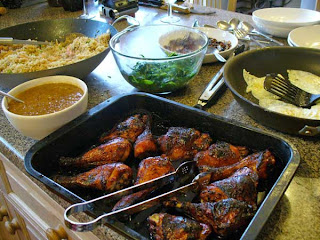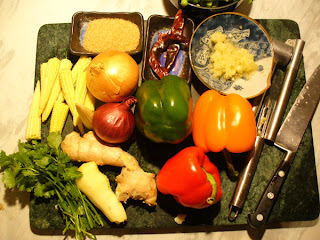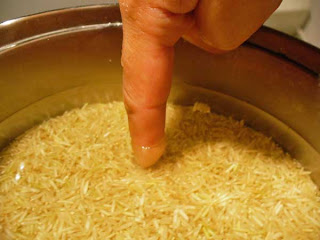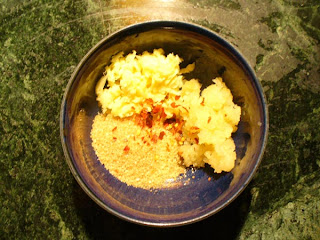
What's in the Chinese kitchen? I can usually knock up a tasty east Asian meal at a moment’s notice without having to send Loved One up the shops and risk him getting lost in the pub while I fret over a smoking wok. You can too if you have the basics stored in the kitchen larder. Having a bag of prawns or seafood in the freezer, or a carton of tofu in the fridge, helps. As do peppers and onions.
The picture above shows a selection of what I was able to draw out from my cupboards just now. It gives me a wide range of flavours and textures with which to turn basic noodles or rice into something heavenly.
The staple of most Asian meals is either rice or noodles. I prefer brown rice or even brown basmati rice because it’s healthier — “punishment rice” as Loved One calls it. He’s more a potato guy but doesn’t look like one, fortunately for me.
The absolute must-have for Chinese cuisine is soy sauce: light or dark. This is fermented soy bean, grain and salt so you can put away the salt-cellar. Other bottles and jars contain: oyster sauce, black bean sauce, fish sauce, hoi sin sauce, plum sauce, BBQ sauce. In a while I’ll show you how to make a basic marinade as taught me by my Dad, but for now, purchased ready-mades will suffice.
I give a curry kick to some dishes using red or green curry paste, laksa paste, or crushed chilli seeds. As a cheat I sometimes use Schwartz Steakhouse Pepper which is gorgeous but expensive in the quantities that I use as it only comes in silly little jars.
Tins of waterchestnuts and bamboo shoots add a lovely texture to basic dishes. Tins of coconut milk, low fat or normal, are great for curries and laksa soup.
Spices should include powdered ginger, turmeric, dried chilli seeds and chillis, and five spice powder. Fresh flavourings come from garlic bulbs, ginger, kaffir lime leaves, lemon grass, coriander and fresh chillis.
Condiments include wasabi mustard, sweet chilli sauce.
Oils. I cook mostly with olive oil, peanut oil, sunflower and sesame. If you are worried about peanut allergy, use rapeseed oil instead. Peanut and rapeseed are what you use when you stir-fry and need to get the oil smoking hot. There’s evidence that high temperatures make lighter, healthier oils such as sunflower and safflower behave like carcinogenic hydrogenated fats, so use as little as possible. I always add a little sesame oil at the end for the wonderful pungent flavour.
If any of this looks so strange that it’s frightening you, don’t worry. I’m going to be walking you through some recipes so you’ll end up confident and familiar with the most exotic foodstuffs.
A basic list of ingredients you should have in your kitchen cupboards and fridge for cooking Asian dishes.
Dry goods:Brown rice, basmati, long grain white rice, Thai jasmine rice
Egg noodles, wheat noodles, rice noodles. Fine and wide.
Dried Chinese/shitake mushrooms (have to soak for around 15 minutes before using)
Pre-soaked dhal (lentils) for South Asian cooking
Sesame seeds
Spices and flavourings:Powdered ginger, turmeric, dried crushed chilli seeds, and five spice powder
Dry kaffir lime leaves and lemon grass
Whole coriander seed
Whole cumin seed
Whole black pepper
Whole dried Chillies
Fish stock cubes (I am such a cheat but who can boil up fish bones for months in order to get half a cup of stock?)
Organic chicken stock cubes. (Ditto)
Schwartz Steak Seasoning (cheats’ ingredient)
Salt (generally not needed if using soy sauce)
Sugar or golden syrup
Sherry or rice wine (chef’s privilege)
Sauces and pastes:Soy sauce: light and dark (light is saltier, dark for marinades)
Tamari (wheat-free soy sauce)
Oyster sauce, black bean sauce, chilli bean sauce, fish sauce, hoi sin sauce, plum sauce, BBQ sauce
Red or green curry paste, laksa paste
Shrimp paste
Sweet chilli sauce (for dipping)
Wasabi mustard (for dipping sashimi and sushi)
Cornflour or rice flour for thickening
Oils:Peanut (groundnut) or rapeseed oil for stir-frying (requires a hot temperature)
Sesame oil
Tins:Tins of waterchestnuts, bamboo shoots
Coconut milk, light or normal fat
Fresh:Garlic bulbs, fresh ginger, kaffir lime leaves, lemon grass, and fresh chillis
Limes
Coriander
Spring onions
Onions
Peppers
Kaffir lime leaves and lemon grass
Freezer/fridge:Frozen pancakes for Peking Duck
Frozen prawns or mixed seafood
Frozen dimsum
Cartons of tofu (beancurd)
Clotted cream. Not Asian but I love it.
Plus fresh fish, meat, fruit and vegetables bought several times per week, if not daily
(Post brought over from WordPress)
 I don't grow much foodstuff in the garden, a situation I must rectify. In the meantime, here are photos of coriander, basil and tomatoes coming along nicely.
I don't grow much foodstuff in the garden, a situation I must rectify. In the meantime, here are photos of coriander, basil and tomatoes coming along nicely.

 And a lone wild strawberry that survived the wood pigeons. They have such a great flavour, a bit like the impossible sweets from childhood. The strawberries, that is, not the pigeons.
And a lone wild strawberry that survived the wood pigeons. They have such a great flavour, a bit like the impossible sweets from childhood. The strawberries, that is, not the pigeons.












 Squid and pigs' ears
Squid and pigs' ears  Roast duck and char siu pork
Roast duck and char siu pork 


















 What you need
What you need Deskinning garlic clove
Deskinning garlic clove Skinned garlic clove
Skinned garlic clove Ready to crush in the press
Ready to crush in the press … and
… and  The finished product.
The finished product. 
